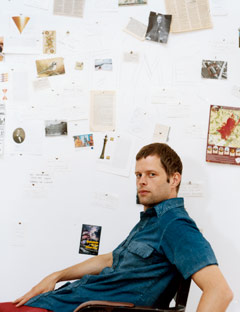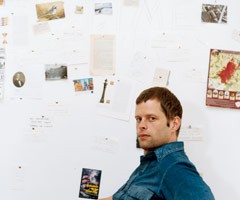
In the span of three novels, John Wray has covered an impressive range of historical, stylistic, and emotional ground. He’s equally at home tracking the parallel paths of an unstable teen and the dogged police officer tracking him across contemporary New York (Lowboy) as he is describing an man’s horror, upon returning to his Austrian hometown in the 1930s, to discover widespread acceptance of fascism among old acquaintances (The Right Hand of Sleep). I first met Wray when we read together at an early Vol.1 event; there, he was reading from a work in progress, a novel that tapped into a more comic side of his style. Over the course of a few months this year, we exchanged a series of emails, covering everything from the current status of that novel to Wray‘s passion for urban exploration.
A couple of years ago, I saw you read an excerpt from a novel-in-progress that was — relative to your other work — more comic. Is this new novel still in progress?
That book — a big crazy novel about a family of time-obsessed physicists, sci-fi authors, war criminals, etc, etc—is still very much in progress. It’s been in progress so long that it starting to feel more like regress to me. According to my editor, it’s nearly done; I can’t tell anymore, to be honest. Sometimes writing a novel—the process of revision, especially — feels like nothing so much as the obsessive-compulsive scratching of an itch: the hope is that someone will step in and force you to stop before serious hemorrhaging occurs. Oof. I guess that sounds a little negative.
What has the reaction been to the Citizen stories on Twitter?
It’s been a pretty big surprise, I have to say. It began as a lark, an attempt to see whether I could find a way to use Twitter—which my wonderful publicist at FSG told me, in no uncertain terms, I had to do—and it continued to be a lark, which is another way of saying that it turned out to be more fun than I’d expected. It got written up a bunch of places as an experiment in “Twitter fiction,” which I suppose it is—though it’s really an experiment in avoiding internet-induced narcissism. A failed experiment in avoiding internet-induced narcissism.
You’ll be teaching a course at the Center for Fiction later this year. How did that come about?
I don’t teach often — not because I don’t enjoy it, but because I can only seem to focus on one thing at a time, so teaching results in my own writing being put on hold. But I have a lot of respect for the folks at the Center for Fiction, and I like the simple fact that it exists; Kathleen Alcott and I thought it might be interesting to teach a workshop as a team, and the CFF liked the idea. The hope is that two writers, with two very distinct points of view, can see more, understand more, and appreciate more than any single teacher would.
You wrote about SunnO))) for the New York Times a few years ago — have you been inspired to do any more writing on music in the time since then?
I loved writing about SunnO))) for the times magazine, and still consider those guys friends. The most recent piece I did was a Spin cover story about Arcade Fire and Spoon, which was also a lot of fun, if for slightly different reasons. I’m a hopeless music geek, so that kind of writing comes pretty naturally.
For A Public Space, you wrote a piece on less-frequented spaces in New York City. Is this kind of unorthodox urban exploration something you’d like to return to?
That piece–‘Impossible Sightseeing: New York City,’ which I did with Matt Dojny–continues to be one of things I get the most response to. Basically, Matt and I wrote about ‘sights’ that one can’t legally (or, in some cases, even physically) visit: the paved-over ‘House of Tomorrow’ at the site of the World’s Fair in Queens, the abandoned asylum on North Brother Island, the library stacks under Bryant Park, and so on. We actually managed to visit some of the sites, which was both hugely enjoyable and more than a little scary. But I’d do it again in a heartbeat.
You’ve written about the rise of fascism in Austria, and the mother of Lowboy‘s protagonist is Austrian. Is that nation’s history something you find yourself revisiting in your work?
Well, the book I’ve been writing for the last five years, The Lost Time Accidents, leapfrogs from a small town in the Czech Republic to Vienna to New York City — more or less as my own family did, on my mother’s side — so it seems I can’t get away from central Europe (and Austria in particular) for long. On the other hand, the next novel (which I can’t wait to start) takes places entirely in Yemen and Afghanistan and Dubai. So I’ll be taking an extended sabbatical from the motherland. It’s best for all concerned.
Some of the sites you’ve written about in your A Public Space piece have changed — or seem be on the verge of change, whether the stacks under the NYPL or the recent accessibility to the City Hall subway station. Famously, the High Line went from a space to visit illicitly to a tourist attraction. What do you anticipate as the next wave of under-the-radar urban spaces in New York City?
It’s fascinating (and a little sobering) to write about the physical features of New York, as I also did in Lowboy. It really drives home how quickly and ruthlessly this city changes. It’s a cliché, of course, to say that this crazy place we live is in a state of constant, violent flux, but it’s frighteningly true. RIP the 42nd Street stacks! Gone but not forgotten! RIP the Howard Johnson’s on Times Square, and the bowtie-sporting cadaver who served the watery cocktails there! RIP the Mars Bar, the most unfriendly nightspot west of Warsaw! RIP Max Fish! RIP Maxwell’s! Etc, etc.
To answer your question: I have no idea. Buildings are easy to put up and tear down, but a ruin needs time (and the proper amount of neglect) to decay. And ruins in this town are getting harder and harder to come by. I suggest we all move to Buffalo.
Follow Vol. 1 Brooklyn on Twitter, Facebook, Google +, our Tumblr, and sign up for our mailing list.

